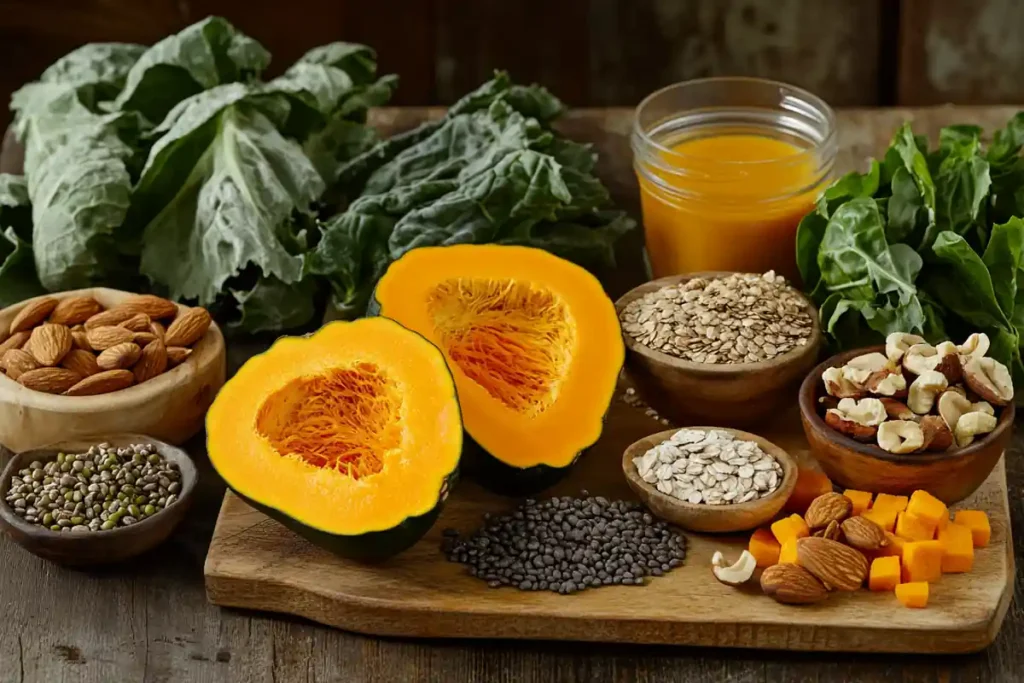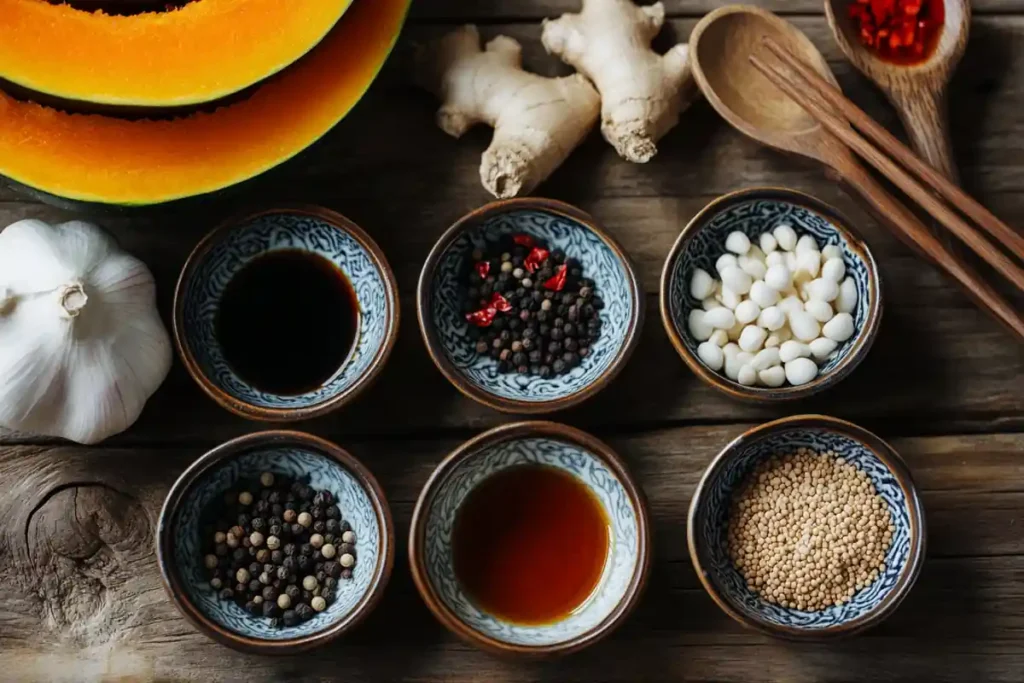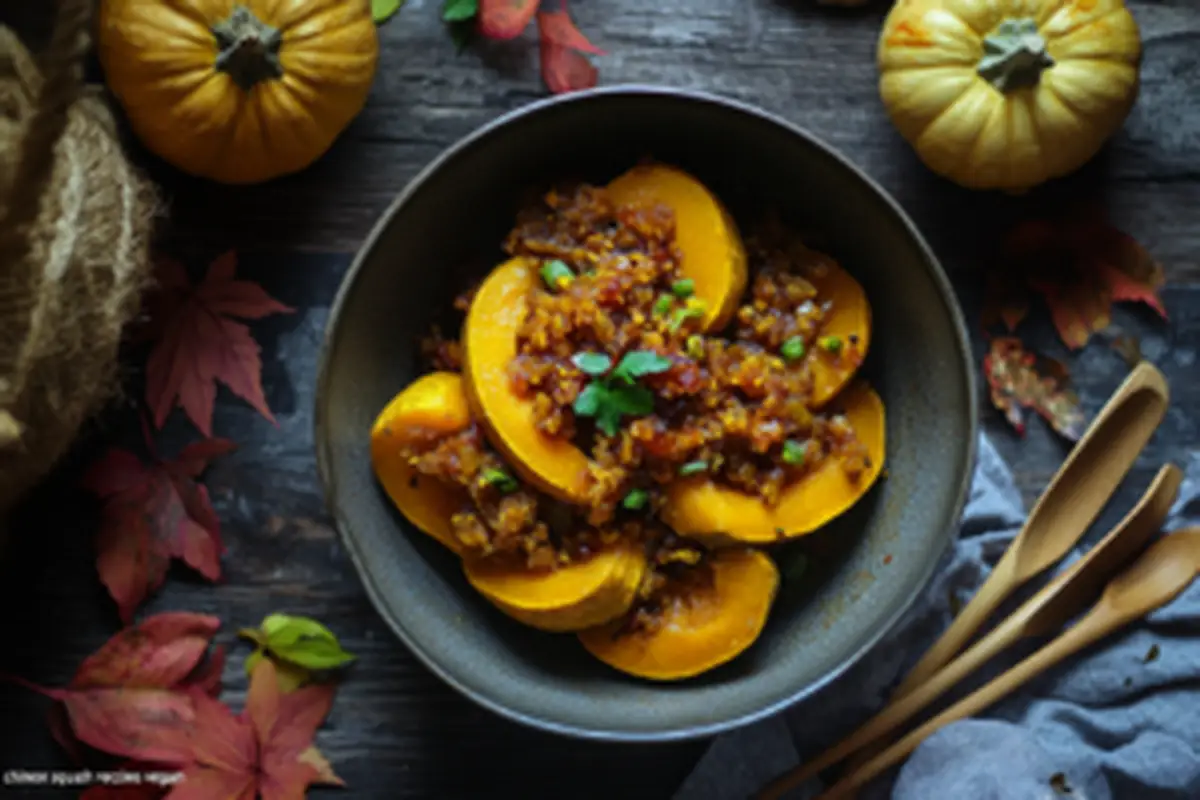Chinese Squash Recipes Kabocha Vegan are simple, vibrant, and healthy meals that celebrate Chinese flavors and plant-based goodness. These dishes highlight the sweet and savory versatility of kabocha squash, a beloved ingredient in Asian cuisines.
Discover the Magic of Kabocha Squash in Chinese Cooking
If you’re looking for delicious Chinese squash recipes with Kabocha that are also vegan, you’ve come to the right place! Kabocha squash, often called Japanese pumpkin, is a staple in many Asian cuisines, including Chinese cooking.
With its naturally sweet, nutty flavor and creamy texture, Kabocha is perfect for a variety of plant-based dishes. Whether you’re stir-frying, roasting, or making a hearty soup, this versatile squash can add depth to any meal.
In this guide, we’ll explore the best Chinese Kabocha squash recipes, cooking techniques, and the nutritional benefits of this incredible vegetable. Let’s dive in!
Why Kabocha Squash is a Must-Try for Vegans

Kabocha squash is a game-changer for plant-based diets. It offers a rich, satisfying texture that makes it an excellent alternative to meat and dairy-based ingredients.
Here’s why you should incorporate Kabocha squash into your vegan meals:
- Naturally Sweet & Buttery: No need for added sugar or fats—Kabocha is delicious on its own.
- High in Fiber: Helps with digestion and keeps you feeling full longer.
- Rich in Beta-Carotene: Supports healthy skin and vision.
- Low in Calories: Perfect for those looking to maintain a balanced diet.
- Works in Both Savory & Sweet Dishes: From soups and stir-fries to desserts, Kabocha does it all!
What is Kabocha Squash? A Guide to This Asian Delight
Kabocha squash is a winter squash variety native to Japan, but it is widely used in Chinese and other Asian cuisines.
The Origins and Cultural Significance of Kabocha
Kabocha is believed to have originated in South America and was introduced to Japan in the 16th century. Today, it is an integral part of Chinese, Korean, and Japanese cuisine.
In Chinese cooking, Kabocha is often used in braised dishes, soups, and stir-fries. It symbolizes prosperity and good health, making it a common ingredient in celebratory meals.
What Does Green Kabocha Squash Taste Like?
Unlike other squash varieties, Kabocha has a unique combination of sweetness and earthiness.
- Texture: Dense, creamy, and starchy (similar to sweet potatoes).
- Taste: A mix between pumpkin and chestnuts, with a hint of nuttiness.
- Best Uses: Works well in roasted dishes, stews, and purees.
Health Benefits of Kabocha Squash for a Vegan Diet
Kabocha squash isn’t just delicious—it’s also packed with essential nutrients that support a plant-based lifestyle.
Nutritional Value of Kabocha Squash
A 1-cup serving of cooked Kabocha squash contains:
| Nutrient | Amount per Cup | Benefits |
|---|---|---|
| Calories | 40 | Low-calorie & diet-friendly |
| Carbs | 10g | Provides energy |
| Fiber | 2g | Supports digestion |
| Vitamin A | 70% DV | Promotes healthy skin & eyes |
| Vitamin C | 15% DV | Boosts immune function |
| Iron | 0.8mg | Essential for blood health |
How Kabocha Supports a Balanced Vegan Lifestyle
- Replaces Starchy Carbs: A great substitute for potatoes or rice.
- Boosts Vitamin A Intake: Important for immune function and skin health.
- Rich in Antioxidants: Helps reduce inflammation and supports heart health.
Essential Ingredients for Chinese Kabocha Squash Dishes

Cooking Chinese squash recipes with Kabocha requires a balance of flavors. The key is to use traditional Chinese ingredients that complement the squash’s natural sweetness.
Classic Chinese Spices and Flavor Enhancers
Chinese cuisine is all about bold and aromatic flavors. Here are some essential spices and seasonings used in vegan Kabocha squash dishes:
- Soy Sauce – Adds umami depth and saltiness.
- Shaoxing Wine – A common Chinese cooking wine that enhances flavor.
- Sesame Oil – Provides a nutty aroma.
- Ginger & Garlic – The perfect aromatic base for many dishes.
- Five-Spice Powder – A blend of cinnamon, cloves, star anise, fennel, and Sichuan peppercorns.
- White Pepper – A common spice in Chinese cooking with a mild heat.
- Chili Oil – Adds a touch of spice to balance sweetness.
- Miso Paste – Although Japanese, this fermented ingredient adds umami richness.
Vegan Substitutes for Traditional Chinese Ingredients
To keep your Kabocha squash recipes fully plant-based, swap out non-vegan ingredients with these alternatives:
| Non-Vegan Ingredient | Vegan Substitute |
|---|---|
| Oyster Sauce | Mushroom Sauce / Hoisin Sauce |
| Fish Sauce | Tamari + Seaweed Flakes |
| Chicken Broth | Vegetable Broth / Mushroom Broth |
| Egg in Batters | Flaxseed or Chia Egg |
How to Prepare Kabocha Squash for Cooking
Preparing Kabocha squash may seem intimidating because of its hard skin, but it’s easier than you think!
Do You Peel Kabocha Squash Before Cooking?
Unlike other squash varieties, Kabocha’s skin is edible when cooked. However, peeling is optional depending on the dish.
- Keep the skin on for roasting, steaming, or stir-frying.
- Peel it if making a smooth soup or puree.
Best Methods for Cutting and Handling Kabocha
Since Kabocha has a tough exterior, follow these steps for easy cutting:
- Microwave for 2 minutes to soften the skin.
- Use a sharp knife to slice it in half.
- Scoop out the seeds with a spoon.
- Cut into wedges or cubes based on your recipe.
Pro Tip: Use a serrated knife if you’re struggling to cut through the skin.
Cooking Methods for Perfect Kabocha Dishes
Now that you’ve prepped your squash, let’s explore different cooking techniques to enhance its flavor.
Stir-Frying Kabocha the Right Way
Best for: Quick meals with a crispy outside and tender inside.
- Heat oil in a wok.
- Add garlic, ginger, and spices.
- Toss in Kabocha pieces and stir-fry until golden brown.
- Add soy sauce or a light broth to steam and soften the squash.
How to Roast Kabocha for a Rich, Caramelized Flavor
Best for: Deep, sweet flavors with crispy edges.
- Preheat oven to 400°F (200°C).
- Toss Kabocha pieces with oil, salt, and spices.
- Roast for 25–30 minutes, flipping halfway.
Steaming Kabocha for Soft and Silky Texture
Best for: Preserving nutrients and creating a soft texture for soups and purees.
- Place Kabocha pieces in a steaming basket.
- Steam over boiling water for 15–20 minutes until fork-tender.
- Use in soups, mashes, or desserts.
10 Must-Try Chinese Squash Recipes with Kabocha
Now that you know how to prepare and cook Kabocha squash, let’s dive into some delicious vegan Chinese recipes. These dishes showcase the squash’s natural sweetness while incorporating classic Chinese flavors.
1. Sweet and Savory Braised Kabocha
This classic Chinese-style braised Kabocha is rich, slightly sweet, and packed with umami flavor.
Ingredients:
- 2 cups Kabocha squash, cut into cubes
- 1 tbsp sesame oil
- 2 cloves garlic, minced
- 1-inch ginger, minced
- 1 tbsp soy sauce
- 1 tbsp Shaoxing wine (optional)
- 1 tsp sugar
- ½ cup vegetable broth
- 1 tsp cornstarch (optional, for thickening)
- ½ tsp white pepper
Instructions:
- Heat sesame oil in a pan and sauté garlic and ginger.
- Add Kabocha and stir-fry for 2 minutes.
- Pour in soy sauce, Shaoxing wine, sugar, and broth.
- Cover and simmer for 10-15 minutes until squash is tender.
- (Optional) Mix cornstarch with 1 tbsp water, add to the sauce, and stir until thickened.
- Serve warm with rice.
2. Vegan Kabocha Squash and Tofu Stir-Fry
A simple protein-rich dish featuring crispy tofu and tender Kabocha in a savory sauce.
3. Kabocha Squash Congee for Comforting Mornings
A nourishing Chinese rice porridge with creamy Kabocha and subtle sweetness.
4. Garlic Ginger Roasted Kabocha Wedges
Perfect as a snack or side dish, these wedges are roasted until crispy on the outside and creamy inside.
5. Spiced Kabocha Squash Soup
A warming and aromatic soup infused with Chinese spices like star anise and five-spice powder.
6. Chinese-Style Stuffed Kabocha Squash
A unique dish where the squash is hollowed out and filled with a savory mushroom and rice stuffing.
7. Vegan Kabocha Squash Curry
A fusion-style dish with coconut milk, curry powder, and Chinese spices.
8. Stir-Fried Kabocha with Shiitake Mushrooms
A simple yet flavorful stir-fry featuring earthy mushrooms and tender squash.
9. Kabocha Squash with Black Bean Sauce
A bold-flavored dish using fermented black beans for a deep umami taste.
10. Sweet Kabocha Red Bean Dessert
A light and nourishing Chinese dessert made with red beans, Kabocha, and rock sugar.
Best Pairings: What to Serve with Kabocha Dishes
To complete your meal, pair Kabocha squash dishes with:
- Steamed jasmine rice or brown rice
- Simple stir-fried greens (bok choy, spinach, or water spinach)
- Hot and sour soup for contrast
- Chili oil or pickled vegetables for extra flavor
FAQs About Chinese Squash Recipes Kabocha Vegan
Here are some commonly asked questions about Kabocha squash in Chinese cooking and how to make the most of it in a vegan diet.
FAQ: Do You Peel Kabocha Squash Before Cooking?
No, you don’t have to peel Kabocha squash. Its skin softens when cooked and adds texture and nutrients. However, if you prefer a smoother dish (such as a puree or soup), you can peel it.
FAQ: What is Kabocha Pumpkin Called in Chinese?
In Chinese, Kabocha squash is commonly called 南瓜 (Nán guā), meaning “pumpkin” or “southern gourd.” Some regions may also refer to it as 金瓜 (Jīn guā), meaning “golden squash.”
FAQ: What Does Green Kabocha Squash Taste Like?
Green Kabocha squash has a sweet, nutty flavor with a texture similar to sweet potatoes or chestnuts. It has a slight earthiness, making it ideal for both savory and sweet dishes.
FAQ: How Can I Store Cooked Kabocha Squash?
Store cooked Kabocha in an airtight container in the refrigerator for up to 5 days. For longer storage, freeze in portions for up to 3 months.
FAQ: Can I Use Kabocha Squash in Desserts?
Yes! Kabocha squash works well in Chinese desserts, such as sweet soups, steamed cakes, and mochi. Its natural sweetness makes it perfect for healthier treats.
FAQ: What is the Best Way to Cook Kabocha for a Vegan Dish?
The best methods for vegan Kabocha dishes include:
Steaming for a soft, natural texture.
Roasting to enhance its sweetness.
Stir-frying with garlic, ginger, and soy sauce.
FAQ: Are There Any Allergens in Kabocha Squash?
Kabocha squash is naturally allergen-free and gluten-free. However, some people with sensitivities to squash or pumpkin may experience mild reactions.

